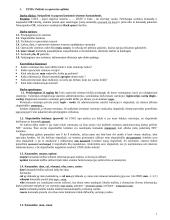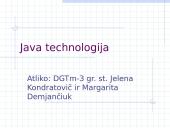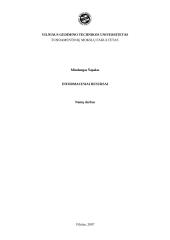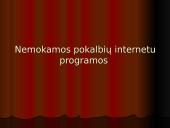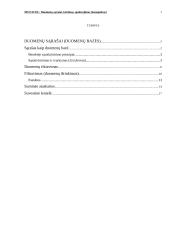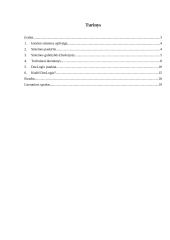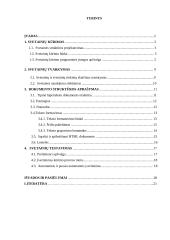Kursiniai darbai
Open Scource Learning Management Systems
Executive Summary This report reviews the following four open source Learning Management Systems: ATutor, Claroline, ILIAS and Moodle. The work is based on a literature review on online education, as well as introductions to open source platforms given on their websites. Table of Contents Terms of Reference……………………………………………………………3 Introduction……………………………………………………………………4 Findings and Analysis…………………………………………………………5 ATutor……………………………………………………………………..5 Claroline…………………………………………………………………...6 ILIAS……………………………………………………………………...7 Moodle…………………………………………………………………….8 Conclusions………………………………………………………………..…10 Recommendations……………………………………………………………10 Glossary………………………………………………………………………11 References……………………………………………………………………14 Terms of Reference This report is an assignment for an MSc module ‘Managing Information’ on postgraduate programme MSc Business Management in Greenwich School of Management. This work aims to evaluate Learning Management Systems as part of the elearning product’s offerings in terms of their features effectiveness and size of the market. Introduction According to Dolezalek (2006), open source software is the last trend of E-Learning market. A lot of organizations, especially in educational sector, are trying out and switching to open source applications that are built for education purpose. At the moment, there are a wide variety of open source systems on the market designed to deliver educational content over Web. However, due to the size limitation of this report, four well-known and mature open source Learning Management Systems (LMS) will be presented. This report overviews the following open source LMS: ATutor, Claroline, ILIAS and Moodle. Their main features, strengths and weaknesses will be described. Findings and Analysis The open source Learning Management Systems overviewed in this report were originally initiated and developed at Universities, as part of “in house” Virtual Learning Environments (VLE). Later on, with the help and support from large users and developers communities spread all over the world. And at the moment are used not only in public educational organizations, but also in big private companies. One such systems, which original development was initiated in university is ATutor. ATutor According to the Edutech (2005) report, ATutor is an open source Web based Learning Content Management System developed by Adaptive Technology Resource Centre University of Toronto and is available under General Public License (GPL). The first public release was in December 2002. As many other LMS, ATuror works with all main Web browsers, for instance, Internet Explorer, Firefox, and Safari, moreover, it also functions with text based web browsers and can be accessed using low bandwidth internet access. ATutor complies with the WCAG standard published by W3C. It does not use frames and has a tool for visually impaired users which transforms web-based text into language and reads it out. An advantageous is that ATutor is very easy to use; the interface is clear and simple. For learning course creation it supports SCORM and IMS content packaging, (Edutech, 2005). ATutor is a multilingual system translated into more that 20 languages, and it allows users to change interface language. What is more that students can search across the course content or even across several courses. In addition, the system has student’s management and activity tracking tools. The Online help and handbooks for the administrators, instructors and developers are available on the official developer’s web site, together with possibility to pay for an additional support, (ATutor, 2007). A report provided by LMSNews (2006) describes ATutor’s course management and creation as very quick and straight forward. This report indicates that ATutor has a lot of potential because of it’s basic options needed for the Web-based group work. However, one of ATutor’s disadvantageous is the navigation in learning area, which may look as overloaded and unstructured, especially for in-experienced users, (LMSNews, 2006). Edutech’s (2006) report names another ATutors’s limitation which is lack of possibility for developers to extend the current system’s functionalities. Despite the limitations, Farrel (2003) nominates ATurtor as number one finalist for the best open source technology using Apache, PHP and MySQL, also for incorporation an awareness of evolving e-Learning specifications. Another, open source Learning Management System similar to ATutur is Claroline. Claroline Claroline project is developed by Catholic University of Louvain and CEDRDECAM (Belgium). The Project was initiated in 2000 by Catholic University of Louvain under financial support from Louvain Foundation and since 2004 is developed together with CERDECAM, research centre of ECAM (Engineering higher school -Belgium), (Edutech, 2005). The developers were keen on developing an open source LMS alternative to the Blackboard (Iain, 2003). Claroline is available for free and it is distributed under GPL license. The system is used in more than 500 organization across 68 countries and it is translated into more than 31 languages (Hall, 2007), including English, German, French and Italian, (Edutech, 2005). The interface language for whole course can be setup by authors and students cannot change it. Claroline has a simple interface and navigation, howerer, it does not allow students to customize the environment. As an open source LMS it has standard range of tools including activity tracking tools with detail static for most course elements and activities, (Claroline, 2007). Generally, course administration is done by teachers. Claroline is based on PHP and MySQL and it also supports SCORM conformant packaging (Edutech, 2005). The system is a platform independent system and it can be run on Windows, Unix, Linux or other operating systems (Hall, 2007). The main strength of Cloaroline is it’s simplicity, which allows to create a course quickly and does not require any additional training, (Edutech, 2005). Edutech’s report (2005) mentiones some Claroline’s weaknesses One of them is the way how ‘Back’ button works. Sometimes it shows unpredictable results and leads to content loss. Another problem described in the same report is an issue with course content, which allows unauthorized access to the documents. LMSNews report (2006) describes Claroline as semi-virtual system with lack of course management features and very few additional modules. However, the latter point could be an advantageous for an inexperienced user, who may want to have a simple and neat system. On the other hand, it could be a drawback for organizations preferring to have a full LCMS. ILIAS, like Craloline is free open source Learning Management System, which started its’ way in one of the Europeans universities and was developed in neighbourhood county Germany. ILIAS ILIAS is developed and coordinated by University of Cologne (Germany) and open source community. It is a web-based collaboration platform and Learning Content Management System (LCMS), (Edutech, 2005). The name ILIAS is an acronym, and from German language it translates as Integrated Learning, Information and Co-Operative System and is available under GPL license, (Hotrum, Ludwig, & Baggaley, 2004). ILIAS is used not only in universities, but also in public and private companies such as Novell or MarZ Consulting (LMSNews, 2007), it is widely used in Germany (Hall, 2007). The developer’s web site indicates that the current version user interface is available in 20 languages, including English, German, French and Italian. ILIAS allows teachers and students to choose their interface language. It supports SCORM and AICC content packaging including LOM (ILIAS, 2007). The platform has flexible course management system and good English language documentation (Hall, 2007). In addition, ILIAS offers a full payable support from hosting and installation to complete design adjustment and setup (LMSNews, 2007) which makes it more attractive for private companies. According to Edutech (2005), ILIAS is based on a LAMP architecture (Linux, Apache, MySql, PHP). It has many possible installation types, and web server and database can be distributed on different servers which is an important feature as it gives the system scalability and allows to distribute resources. ILIAS can be used with different Web browsers such as Internet Explorer, Safari, Lynx and Mozilla, and it runs with JavaScript disabled. It is frames-based system, which does not support text only based navigation and can not be used with scalable fonts (Hotrum, Ludwig, & Baggaley, 2004). This is a problem for visually impaired students who are using text recognition software. In COL report in 2003 nominated ILIAS as second choice after ATutor, and it was described as highly scalable. With a concern that most of user and development community are based in Germany, it might be difficult to introduce change or influence the roadmap of the product (Farrel, 2003). In Graf’s and List’s report (2003) on LMS adaptation issues described ILIAS’s as it “obtained the best values in the categories technical aspects, administration and course management”, (Graf and List, 2003) and was ranked second after Moodle. And finally the last open source platform overviewed in this report is Moodle. Moodle B. Hall (2007) describes Moodle as the best-known and most popular open source Learning Content Management System (LCMS). According to the developers web site, Moodle is a Course Management System (CMS) and it is specialized in online course editing, (LMSNews, 2006). Moodle website indicates that development was started by Martin Dougiamas and 1.0 version was released in August 2002. The actual name Moodle is the acronym and stands for Modular Object-Orientated Dynamic Learning Environment. System is published under GNU public license and as all other LMS overviewed in this report, - is available for free of charge. It can be run on any Windows, Mac Os or Linux based system as long as the system will support PHP and SQL type database. It is SCORM compliant. Setup is very simple, done through installation routine and it does not require a dedicated server, (LMSNews, 2006). As one of many strengths of Moodle is interface, it is clean, uncluttered, easy understandable and it allows for user to get started quickly, (Edutech, 2005). Like other LMS, Moodle consists of many different modules which have all important functions and tools, well know from other LMS, (LMSNews, 2006). However additional tools or modules are more advanced comparing with other open source LMS, (Edutech, 2005). Moodle has the very large community, with more than 7 million users, from 160 countries across the world, with more that 700,000 courses in 75 languages, (Hall, 2007). It also provides a payable support, (Moodle, 2007), which makes the system even more attractive for private sector. Moodle is widely used in academic world, and even in big private companies. It is highly scalable and such companies like Open University with hundreds of thousands of students have chosen Moodle as their VLE, (Shepherd, 2006). The system is well documented, and besides that there are few proper books available from O’Reilly and Packt Publishing, (2007, Moodle). In evaluation research done by S. Graf and B. List (2003) on open source LMS adaptation issues, Moodle dominated the evaluation by achieving best value five times, (Graf and List, 2003). In 2006 UK’s government’s funded survey on open source software, in LMS category, Moodle scored 56% as choice for UK FE institutions, (Aberdour, 2006 ). Conclusions All four open source Learning Management Systems (LMS), reviewed in this report have good characteristics and more or less similar features, according to the reports done by Edutech, (2005) and LMSNews, (2006 – 2007). In the evaluations done by Farrel, (2003) and Graf & List (2003), all system four systems came very close behind of each other. The only major difference between them all, would be that Moodle has the biggest community size and is available in more languages than other open source LMS. And because of that, it has a bigger potential to be develop and improved faster than other platforms. Recommendations More technical information and documentation could be obtained from the developers websites of each system. Side-by-side comparisons of the open source LMS platforms, together with detail lists of features are available on independent reviewers, like EduTools or LMSNews websites. Glossary AICC – The Aviation Industry CBT (Computer-Based Training) Committee (AICC) is an international association of technology-based training professionals. The AICC develops guidelines for aviation industry in the development, delivery, and evaluation of CBT and related training technologies, The term "AICC Compliant" means that a training product complies with one or more of the 9 AICC Guidelines & Recommendations (AGR's), (AICC, 2007). Apache – a popular web server, with a range of standard features – other more advanced features are available through optional add-in modules, (BECTA, 2005). E-Learning – E-learning is mostly associated with activities involving computers and interactive networks simultaneously. The computer does not need to be the central element of the activity or provide learning content. However, the computer and the network must hold a significant involvement in the learning activity,(Tsai,& Machado, 2007). GPL – GNU General Public License. The GNU General Public License is a Free Software license. Like any Free Software license, it grants to you the four following freedoms: to run the program for any purpose, to study how the program works and adapt it to your needs, to redistribute copies, to improve the program and release your improvements to the public. Full GNU General Public License is available at
Šį darbą sudaro 3001 žodžiai, tikrai rasi tai, ko ieškai!
★ Klientai rekomenduoja
Šį rašto darbą rekomenduoja mūsų klientai. Ką tai reiškia?
Mūsų svetainėje pateikiama dešimtys tūkstančių skirtingų rašto darbų, kuriuos įkėlė daugybė moksleivių ir studentų su skirtingais gabumais. Būtent šis rašto darbas yra patikrintas specialistų ir rekomenduojamas kitų klientų, kurie po atsisiuntimo įvertino šį mokslo darbą teigiamai. Todėl galite būti tikri, kad šis pasirinkimas geriausias!
Norint atsisiųsti šį darbą spausk ☞ Peržiūrėti darbą mygtuką!
- Programų kursinis darbas
- 15 psl., (3001 ž.)
- Word failas 132 KB
- Lygis: Universitetinis
- ✅ Yra šaltiniai
Mūsų mokslo darbų bazėje yra daugybė įvairių mokslo darbų, todėl tikrai atrasi sau tinkamą!
Panašūs darbai
Kiti darbai
Privalumai
Atsisiuntei rašto darbą ir neradai jame reikalingos informacijos? Pakeisime jį kitu nemokamai.
Pirkdamas daugiau nei vieną darbą, nuo sekančių darbų gausi 25% nuolaidą.
Išsirink norimus rašto darbus ir gauk juos akimirksniu po sėkmingo apmokėjimo!
Atsiliepimai






















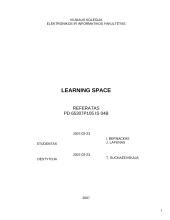
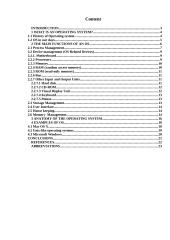
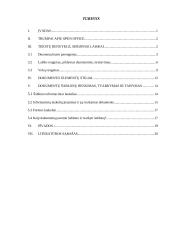


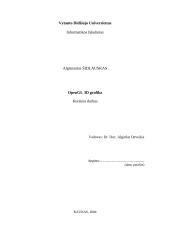
![SQL kalboje naudojama užklausa [SELECT] ir pagrindinės jos funkcijos](/thumbs/51047/sql-kalboje-naudojama-uzklausa-select-ir-pagrindines-jos-funkcijos-0.jpg)
